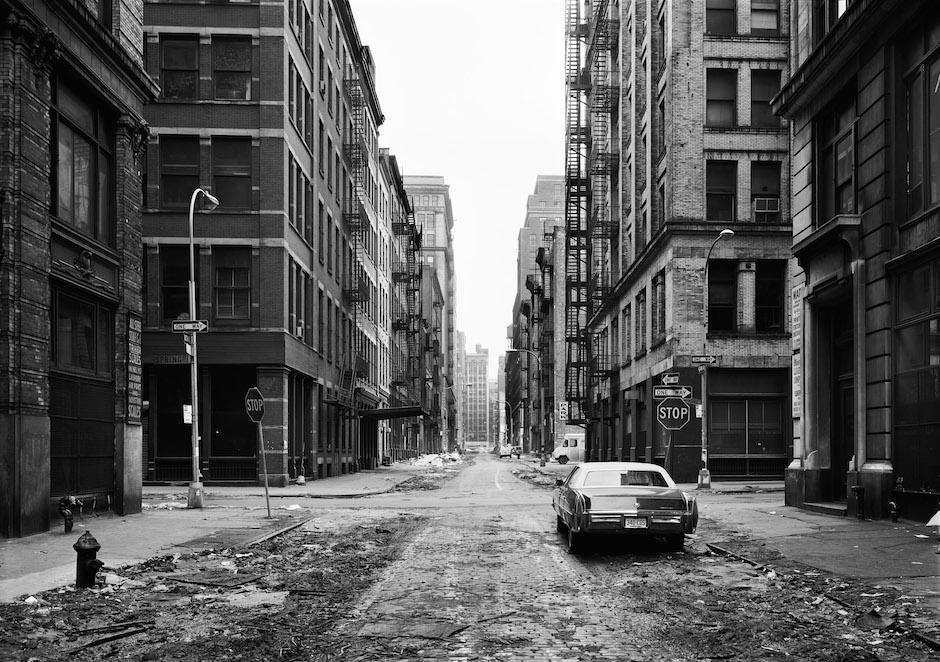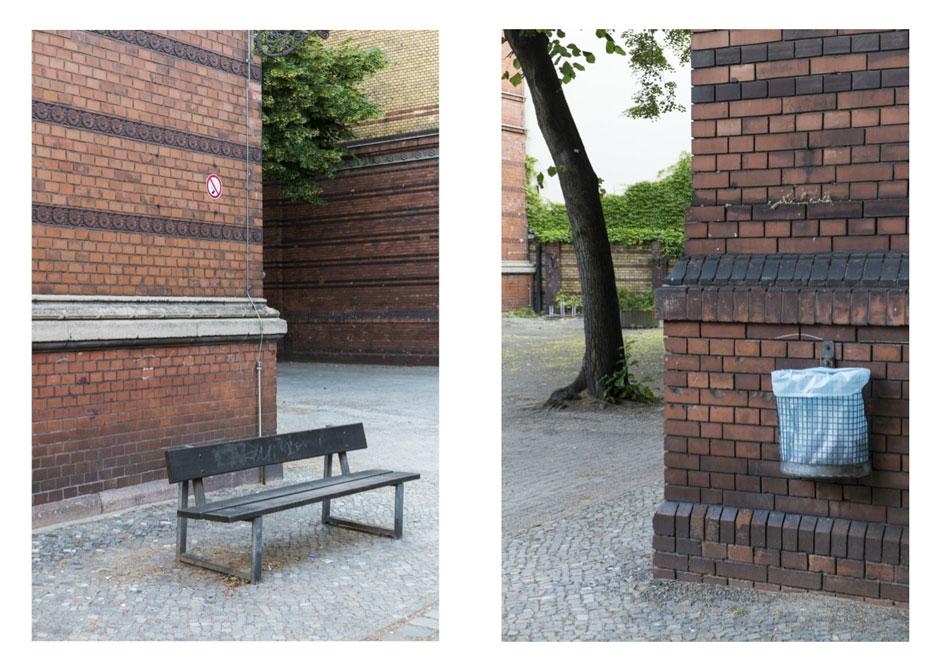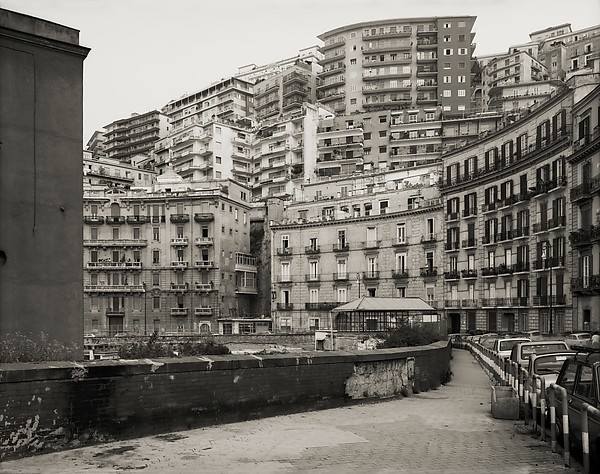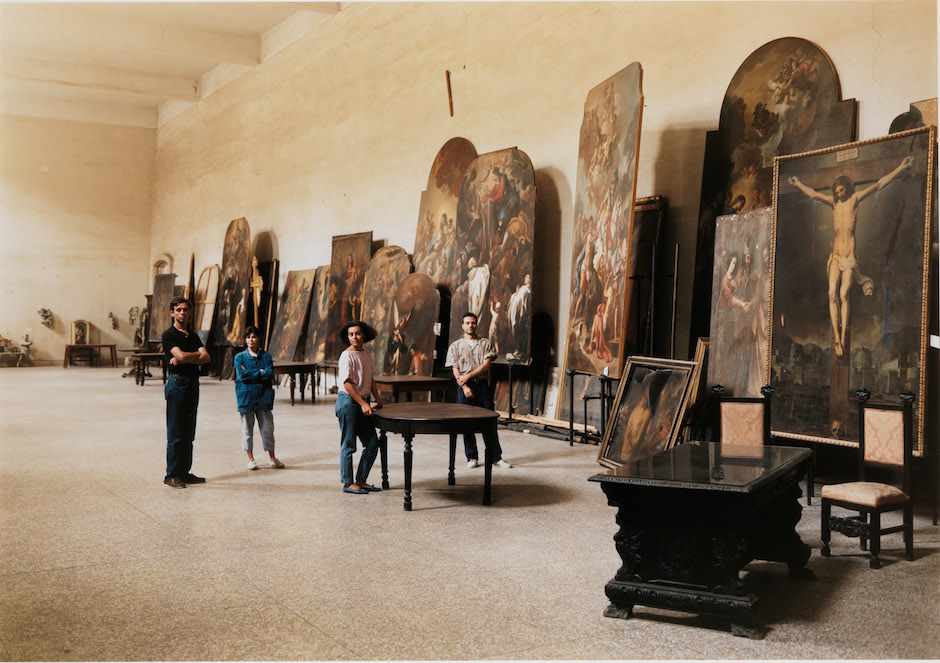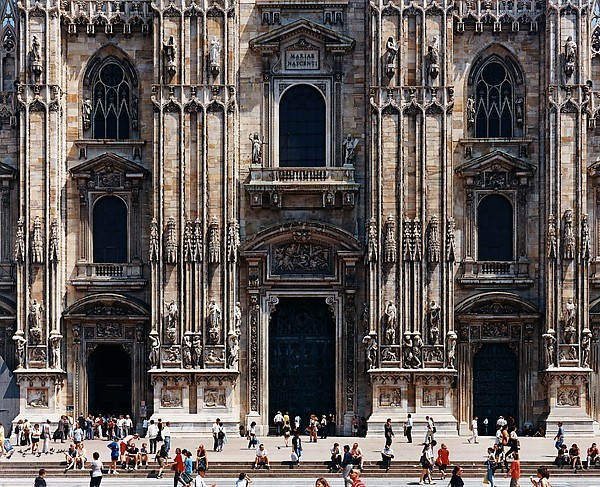Last year the German photographer Thomas Struth published Walking, a small and disarming paperback containing some 140 color photographs. The pictures are mostly portrait format, nearly filling each page at 3.5 by 5.5 inches, and show tightly cropped street corners, façades, and doorways in Berlin and several other European and American cities. But the photos aren’t captioned or otherwise identified; it’s the textures, juxtapositions, and light and wear on stone and plaster that grow eloquent as you flip through the volume.
Deadpan is a word often applied to the minimalism of much contemporary photography, generally to suggest a picture’s blank refusal to betray any hint of lyricism or straightforward beauty, but I think these little photographs clarify how the deadpan tone actually achieves its effects. Every expressive element is muted or cropped out, just up to the point where what’s shown—say a baby-blue garbage bag tucked into a wire wastebasket that’s nailed up against an old brick wall—seems about to speak. Over and over again, but with a joyous variety of forms, Struth reveals signs of successive human interventions in the sorts of everyday places most of us prefer not to see. The wit of these minor revelations is like a species of modernist collage.
A human figure appears in only three of the images yet the entire series feels remarkably personal; in an afterword Struth writes that he took the photographs “by rubbing my shoulders and my senses against ordinary, everyday architecture again.” This seems to acknowledge the project’s departure from the monumental rhetoric of most of his other work, from the late 1970s to his current show at the Metropolitan Museum, where twenty-five photographs spanning his entire career are assembled in a kind of “greatest hits” homage. Any selection so small would invite quarrels about what’s left out, but coming just a decade after Struth’s major retrospective at the Met and including only one photograph from recent years, this show seems prompted by a desire more to air out the museum’s Struth holdings than to take a really fresh look at his work.
Struth began painting at Düsseldorf’s Kunstakademie in the late 1970s but quickly moved to photography, and on Gerhard Richter’s advice studied with the husband-and-wife photographers Bernd and Hilla Becher. No doubt influenced by the Bechers’ extensive series of coal plants and other neglected mammoths of industrial architecture, Struth started taking black-and-white, strictly composed streetscapes, always from the same symmetrical perspective in the middle of a street looking down to its vanishing point, and early in the morning so the scene would be deserted. He eventually photographed some fifty cities worldwide in this way.
A dozen of these images are included in the Met exhibition, all taken in Manhattan in 1978, and their effect is exceedingly dry and serious. They seem, with their sameness of composition, like tireless attempts to show visually something that can’t be captured in a photograph—the entire system of a society, as manifested in city streets, sidewalks, parked cars, streetlights, and unplanned jumbles of façades. Nobody appears in these photos, nothing is “happening” in them. Rather than obeying the modernist notion of the photographer as a heroic hunter in a forest of constant flux, able to foresee and capture every “decisive moment,” Struth’s images catch the history of a place the way a reservoir catches rainwater. He just gets up early, sets up his tripod, and stands very still.
This initial body of work is a reminder that Struth’s early career coincided with the “New Topographics” photographers, whose group show in Rochester, New York, in 1975, set the tone for subsequent landscape photography and remains influential today (the show also included some of the Bechers’ photographs). Its aesthetic, to summarize ten photographers in one sentence, aimed at radical anonymity, as if in protest against the conventions of the picturesque—against not just obviously pretty landscape photographs but also ones too ready to convey any definite mood. In different ways the New Topographics photographers all sought to achieve a documentary quality so drained of emotion that their work tended to arouse reactions like this one, from an exasperated critic writing of Robert Adams and Emmet Gowin: “I felt I was looking at pictures made without any human direction by mere machines programmed to go off at set intervals and photograph whatever happened to be in front of them.”
Today this seems blind for two reasons: one, it’s impossible to ignore the formal beauty of these photographs, and two, leafing through the group’s New Topographics catalog one soon suspects that the reports of their deadly anonymity are greatly exaggerated. Not only is each photographer’s style recognizably distinct (an inescapable outcome for artists aiming to flee “style”), but a sense of profound human curiosity—to really see how our fellow citizens live, as free from numbing visual conventions as possible—competes with the show’s claims of cool “objectivity.” Some of the photographs show brutal tract housing and vacant lots like scars on the desert, and while they propose an atomized new aesthetic they also seem to ask, “How can people live like this?”
Advertisement
That kind of ambiguity applies to Struth’s early streetscapes as well: in Crosby Street, New York (Soho), from 1978—one of his rigidly symmetrical streetscapes—the photograph’s formal rigor is in danger of being upstaged by the rutted, practically war-torn surface of the pavement in the foreground. But in the 1980s Struth moved away from this more conceptual approach toward larger formats, and from symmetry toward freer compositions. Three of these later, larger black-and-white photographs are included at the Met, showing buildings in Geneva, Naples, and Venice, always from the level of a passerby, and at an angle that allows the façades to stack up in suggestive ways. Struth seems to want his lens to get close enough to ordinary buildings that their walls reach almost every edge of the photograph, with little room for sky. The inundation of the frame, the ampleness of what is shown of these massive apartment blocks and dim back alleys, somehow generates a sense of warmth rather than the chill you might expect.
Moving into this middle period of Struth’s career, the images turn to color, grow enormous, more tranquil, more fearless about picturing grandeur. He began taking monumental photographs inside museums and cathedrals, showing people gazing up at artworks and sacred architecture. Often the photographs suggest obvious analogies between the poses or groupings of the gazing people and the gazed-upon artworks; it’s as if the gaze of aesthetic appreciation were itself the photograph’s subject. Struth’s 1990 photograph of tourists dwarfed by the Pantheon’s coffered ceiling and marble-slab floor design (included at the Met) does this particularly well.
The challenge of producing such large prints is evident in this show. A large-format color flyer is piled up in the Met’s gallery for museum visitors to take home, like a free catalog, illustrating almost all the photos on the walls plus a handful of other Struth photographs in the Met’s collections. Unfortunately this emphasizes what seems like accidental blurring in two impressive photos—a lush, mossy forest in Paradise 13, Yakushima, Japan (1999) and a stark, coppery industrial interior in Hot Rolling Mill, ThyssenKrupp Steel, Duisburg (2010)—which look indistinct in the five-by-six-foot prints on the walls, with too much contrast and patches of deep darkness effacing the full load of visual information they seem intended to convey, whereas on the page they’re reproduced in crisp and even detail.
One of the things the Met’s small selection of photographs fails to suggest is how difficult it is to impose a linear trajectory on Struth’s career. Around the time he was taking the great serene photographs on view here (from the mid-1980s through the 1990s), he was also photographing less appealing subjects that aren’t included in the show: chaotic urban markets, soulless intersections, and narrow, tumbledown streets—mostly it seems in Asia and Italy. He photographed these places with merciless indifference to notions of order or composition (Struth’s great strength), and the intention seems to be just to show what is there. The way they lay a transparency over “the real” may suggest how disorienting the “New Topographics” photographs were at the time they were made.
As if to further complicate notions of Struth’s aesthetic, toward the end of the 1980s he also started photographing family groups. These portraits have been highly praised, usually in language that seems grounded in assumptions about Method acting: Struth spent months or even years with his subjects before photographing them, and then he and they “together developed precisely how they wished to be seen” (to quote the catalog of his 2003 retrospective), so the results are thought to reflect the depth of that encounter.
Two well-known portraits are included in the Met show, and I know I bring a minority report when I say they strike me as glossy and affected. In one, an art-collecting couple in Edinburgh, Eleanor and Giles Robertson (1987), sit at a wooden table. In The Restorers at San Lorenzo Maggiore, Naples (1988), four young art restorers stand in a great gallery of enormous oil paintings that they’ve helped bring back to life. Both photographs are technically impeccable. But in both, the subjects cross their arms or cradle their cheeks with a posed complacency that is jarring when compared to the open-ended detachment of Struth’s cityscapes. I can’t help seeing this in his many other photographs of family groups: they always remind me of expensive studio portraits or even album covers. The problem, I think, is that some unexpected current, usually generated in the exchange between photographer and subjects, goes dead when he asks them how they want to be seen.
Advertisement
And Struth’s work in particular, so long involved with attempts to convey a regal objectivity, seems lost when dictated by the subject’s gaze. One of his most impressive cathedral photographs is included in this show: Milan Cathedral (façade) (1998), whose eight-by-six-foot frame is almost entirely filled with the façade’s amber-colored stone and carvings, its steps littered with the tiny polychrome figures of tourists. One of them, in an ingenious detail straight from the canon of “decisive moments,” has her back to us and is taking her own picture of the place just as Struth takes his. The caryatids on the cathedral match the scale of the living people on the steps, and the print’s oxygenated clarity seems to invite comparisons between the two groups.
As I stood in the gallery a few weeks ago, trying to understand the splendor and technical accomplishment of this photograph, I overheard a man say to his friend: “Remember the Gerhard Richter we saw [of the same church] taken from the side and you could see the whole avenue to the left, it was like a painting. And these [photos by Struth] are just like so…” His voice trailed off, and then he added in a tone of real annoyance: “Like my mother could’ve taken this picture.” The fact that Richter’s image of the cathedral (Domplatz, Mailand, 1968) is actually an oil painting (intended to evoke and question the descriptive capabilities of photography) shouldn’t detract from the man’s feeling that something important was missing from this photograph.
Perhaps what’s missing from Struth’s image is a traditional point of view, quite literally. The cathedral’s façade is seen from an almost unrealistically frontal perspective, every detail appearing to be equidistant from the camera’s lens, as if its eye were everywhere at once. (And to say the least it’s a feat that few of us, or our mothers, could achieve with our point-and-shoot cameras.) As Struth told an interviewer in 1978, “I’m interested in photographs that have no personal signature.”
This show at the Met is an interesting experiment: it seems presented as an introduction to Struth’s oeuvre, yet it’s so selective that it risks boring people who aren’t already steeped in photography of the 1970s and 1980s or equipped to see the entire landscape of images that extends behind these few photos by Struth. Such new viewers would, I expect, be won over by the small photos of urban architecture—cool but intimate—in his book Walking. One of the remarkable lessons of Struth’s forty-year career is what great range—and how expressive a style—is available within an approach that aspires to complete neutrality.
Thomas Struth: Photographs, is on view at the Metropolitan Museum of Art in New York through February 16. Struth’s book Walking was published by Ivory Press in 2014.

